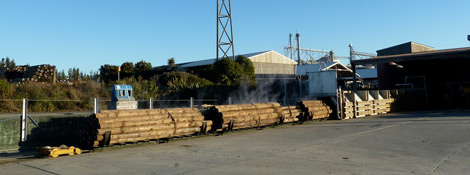What Makes a Good TTT Pole?
TTT Products are leading manufacturers of a comprehensive range of consistent, high quality timber poles. Great quality poles are made from reliable source material combined with technological know-how and skilled staff.
Source Material
TTT sources NZ Radiata Pine logs from sustainably managed forests using responsible logging contractors. Each log is harvested when approximately 25 years old.
Why use Radiata Pine? Radiata Pine is an exotic species which makes up 90% of NZ’s commercial plantation forests. More than 1.5 million hectares of Radiata Pine is planted in NZ which makes up one third of the world’s total Radiata Pine stocks. It is a renewable resource. Radiata Pine is also very durable and likely to be the world’s most treatable wood species due to superior timber preservative penetration and uptake.
Logs are supplied in accordance with TTT’s stringent Log Supply Specification. This Specification covers such things as the form (roundness) of the log, knot sizes, sweep (straightness), taper, and the requirement to be free of decay or insect attack.
Upon delivery, the logs are inspected by TTT’s skilled staff to ensure compliance with the Log Supply Specification.
Processing
Poles are either debarked, machine-peeled, or rounded, then graded to ensure compliance with NZS 3605:2001 Timber Piles and Poles for Use in Building. Together with careful handling and storage this results in consistent, high quality TTT poles.
All TTT poles are steamed (to release the moisture from the wood cells in order for the timber preservative to penetrate) then treated to Hazard Class H5 as per NZS 3640:2003 Chemical Preservation of Round and Sawn Timber to provide protection against fungal and insect attack in an in-ground, critical use situation. Preservative treated timber poles can offer a limited lifetime warranty of 50 years for H1 to H5 Hazard Classes. Refer to Koppers Treatment Wood Product Warranty.
After treatment the timber preservative is ‘fixed’ into the wood using our effective fixation process to minimise leaching of any surface preservative from the poles. When we say ‘effective’ we mean it – not many, if any, treatment plants ‘fix’ the timber preservative successfully into the wood cells. This is an extra process which simply means TTT poles do not drip timber preservative after fixation has been completed.
TTT is a registered CCA Oxide Timber Preservative Treatment Plant and are independently audited on a regular basis. In addition, TTT carry out further sampling, over and above the NZ Timber Preservation Council requirements as part of our quality control programme.
All TTT poles are tagged with SED/diameter, length, Hazard Class and Preservative Code recorded. Each pole is also tagged with a steam charge and treatment charge number.
Density vs High Strength Poles
High Density poles are often specified as they are considered to have certain strength attributes greater than normal density poles. There’s a lot of debate about how density relates to strength, and how density is determined. Some pole manufacturers claim they purchase logs from high density log growing areas; and others run a ‘wand’ over the log and determine density that way. The only way to actually determine a particular strength attribute is to test poles on a calibrated proof-testing rig. TTT can provide verified High Strength poles that have been proof-tested on our Certified Pole Testing rig – refer to TTTested page.
 |
 |
 |
 |
 |
|
